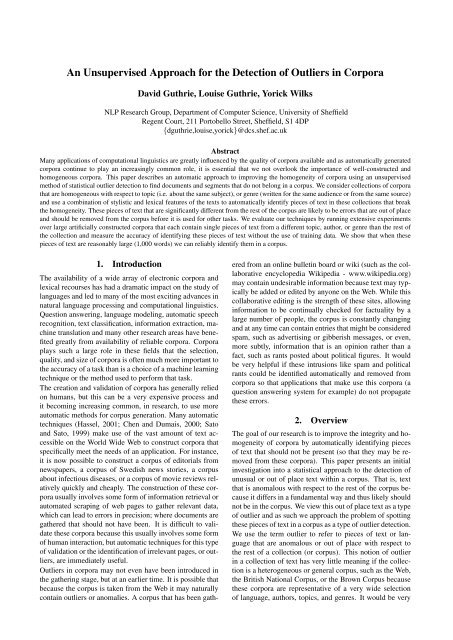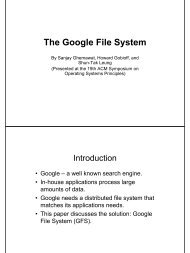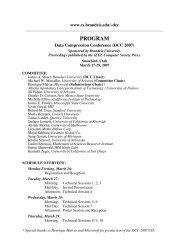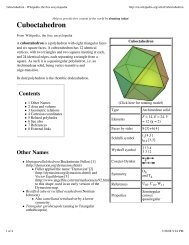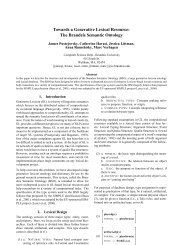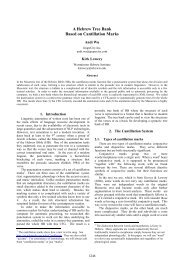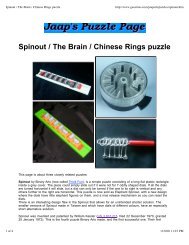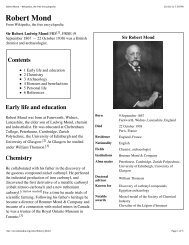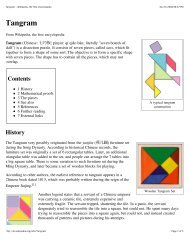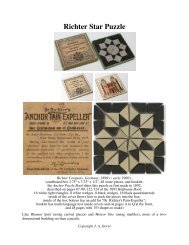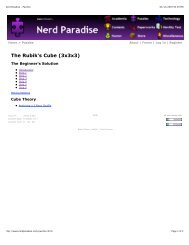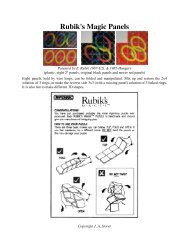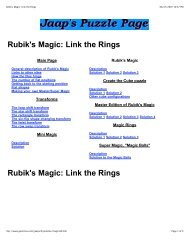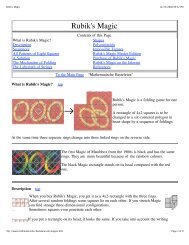An Unsupervised Probabilistic Approach for the Detection of
An Unsupervised Probabilistic Approach for the Detection of
An Unsupervised Probabilistic Approach for the Detection of
Create successful ePaper yourself
Turn your PDF publications into a flip-book with our unique Google optimized e-Paper software.
<strong>An</strong> <strong>Unsupervised</strong> <strong>Approach</strong> <strong>for</strong> <strong>the</strong> <strong>Detection</strong> <strong>of</strong> Outliers in Corpora<br />
David Guthrie, Louise Guthrie, Yorick Wilks<br />
NLP Research Group, Department <strong>of</strong> Computer Science, University <strong>of</strong> Sheffield<br />
Regent Court, 211 Portobello Street, Sheffield, S1 4DP<br />
{dguthrie,louise,yorick}@dcs.shef.ac.uk<br />
Abstract<br />
Many applications <strong>of</strong> computational linguistics are greatly influenced by <strong>the</strong> quality <strong>of</strong> corpora available and as automatically generated<br />
corpora continue to play an increasingly common role, it is essential that we not overlook <strong>the</strong> importance <strong>of</strong> well-constructed and<br />
homogeneous corpora. This paper describes an automatic approach to improving <strong>the</strong> homogeneity <strong>of</strong> corpora using an unsupervised<br />
method <strong>of</strong> statistical outlier detection to find documents and segments that do not belong in a corpus. We consider collections <strong>of</strong> corpora<br />
that are homogeneous with respect to topic (i.e. about <strong>the</strong> same subject), or genre (written <strong>for</strong> <strong>the</strong> same audience or from <strong>the</strong> same source)<br />
and use a combination <strong>of</strong> stylistic and lexical features <strong>of</strong> <strong>the</strong> texts to automatically identify pieces <strong>of</strong> text in <strong>the</strong>se collections that break<br />
<strong>the</strong> homogeneity. These pieces <strong>of</strong> text that are significantly different from <strong>the</strong> rest <strong>of</strong> <strong>the</strong> corpus are likely to be errors that are out <strong>of</strong> place<br />
and should be removed from <strong>the</strong> corpus be<strong>for</strong>e it is used <strong>for</strong> o<strong>the</strong>r tasks. We evaluate our techniques by running extensive experiments<br />
over large artificially constructed corpora that each contain single pieces <strong>of</strong> text from a different topic, author, or genre than <strong>the</strong> rest <strong>of</strong><br />
<strong>the</strong> collection and measure <strong>the</strong> accuracy <strong>of</strong> identifying <strong>the</strong>se pieces <strong>of</strong> text without <strong>the</strong> use <strong>of</strong> training data. We show that when <strong>the</strong>se<br />
pieces <strong>of</strong> text are reasonably large (1,000 words) we can reliably identify <strong>the</strong>m in a corpus.<br />
1. Introduction<br />
The availability <strong>of</strong> a wide array <strong>of</strong> electronic corpora and<br />
lexical recourses has had a dramatic impact on <strong>the</strong> study <strong>of</strong><br />
languages and led to many <strong>of</strong> <strong>the</strong> most exciting advances in<br />
natural language processing and computational linguistics.<br />
Question answering, language modeling, automatic speech<br />
recognition, text classification, in<strong>for</strong>mation extraction, machine<br />
translation and many o<strong>the</strong>r research areas have benefited<br />
greatly from availability <strong>of</strong> reliable corpora. Corpora<br />
plays such a large role in <strong>the</strong>se fields that <strong>the</strong> selection,<br />
quality, and size <strong>of</strong> corpora is <strong>of</strong>ten much more important to<br />
<strong>the</strong> accuracy <strong>of</strong> a task than is a choice <strong>of</strong> a machine learning<br />
technique or <strong>the</strong> method used to per<strong>for</strong>m that task.<br />
The creation and validation <strong>of</strong> corpora has generally relied<br />
on humans, but this can be a very expensive process and<br />
it becoming increasing common, in research, to use more<br />
automatic methods <strong>for</strong> corpus generation. Many automatic<br />
techniques (Hassel, 2001; Chen and Dumais, 2000; Sato<br />
and Sato, 1999) make use <strong>of</strong> <strong>the</strong> vast amount <strong>of</strong> text accessible<br />
on <strong>the</strong> World Wide Web to construct corpora that<br />
specifically meet <strong>the</strong> needs <strong>of</strong> an application. For instance,<br />
it is now possible to construct a corpus <strong>of</strong> editorials from<br />
newspapers, a corpus <strong>of</strong> Swedish news stories, a corpus<br />
about infectious diseases, or a corpus <strong>of</strong> movie reviews relatively<br />
quickly and cheaply. The construction <strong>of</strong> <strong>the</strong>se corpora<br />
usually involves some <strong>for</strong>m <strong>of</strong> in<strong>for</strong>mation retrieval or<br />
automated scraping <strong>of</strong> web pages to ga<strong>the</strong>r relevant data,<br />
which can lead to errors in precision; where documents are<br />
ga<strong>the</strong>red that should not have been. It is difficult to validate<br />
<strong>the</strong>se corpora because this usually involves some <strong>for</strong>m<br />
<strong>of</strong> human interaction, but automatic techniques <strong>for</strong> this type<br />
<strong>of</strong> validation or <strong>the</strong> identification <strong>of</strong> irrelevant pages, or outliers,<br />
are immediately useful.<br />
Outliers in corpora may not even have been introduced in<br />
<strong>the</strong> ga<strong>the</strong>ring stage, but at an earlier time. It is possible that<br />
because <strong>the</strong> corpus is taken from <strong>the</strong> Web it may naturally<br />
contain outliers or anomalies. A corpus that has been gath-<br />
ered from an online bulletin board or wiki (such as <strong>the</strong> collaborative<br />
encyclopedia Wikipedia - www.wikipedia.org)<br />
may contain undesirable in<strong>for</strong>mation because text may typically<br />
be added or edited by anyone on <strong>the</strong> Web. While this<br />
collaborative editing is <strong>the</strong> strength <strong>of</strong> <strong>the</strong>se sites, allowing<br />
in<strong>for</strong>mation to be continually checked <strong>for</strong> factuality by a<br />
large number <strong>of</strong> people, <strong>the</strong> corpus is constantly changing<br />
and at any time can contain entries that might be considered<br />
spam, such as advertising or gibberish messages, or even,<br />
more subtly, in<strong>for</strong>mation that is an opinion ra<strong>the</strong>r than a<br />
fact, such as rants posted about political figures. It would<br />
be very helpful if <strong>the</strong>se intrusions like spam and political<br />
rants could be identified automatically and removed from<br />
corpora so that applications that make use this corpora (a<br />
question answering system <strong>for</strong> example) do not propagate<br />
<strong>the</strong>se errors.<br />
2. Overview<br />
The goal <strong>of</strong> our research is to improve <strong>the</strong> integrity and homogeneity<br />
<strong>of</strong> corpora by automatically identifying pieces<br />
<strong>of</strong> text that should not be present (so that <strong>the</strong>y may be removed<br />
from <strong>the</strong>se corpora). This paper presents an initial<br />
investigation into a statistical approach to <strong>the</strong> detection <strong>of</strong><br />
unusual or out <strong>of</strong> place text within a corpus. That is, text<br />
that is anomalous with respect to <strong>the</strong> rest <strong>of</strong> <strong>the</strong> corpus because<br />
it differs in a fundamental way and thus likely should<br />
not be in <strong>the</strong> corpus. We view this out <strong>of</strong> place text as a type<br />
<strong>of</strong> outlier and as such we approach <strong>the</strong> problem <strong>of</strong> spotting<br />
<strong>the</strong>se pieces <strong>of</strong> text in a corpus as a type <strong>of</strong> outlier detection.<br />
We use <strong>the</strong> term outlier to refer to pieces <strong>of</strong> text or language<br />
that are anomalous or out <strong>of</strong> place with respect to<br />
<strong>the</strong> rest <strong>of</strong> a collection (or corpus). This notion <strong>of</strong> outlier<br />
in a collection <strong>of</strong> text has very little meaning if <strong>the</strong> collection<br />
is a heterogeneous or general corpus, such as <strong>the</strong> Web,<br />
<strong>the</strong> British National Corpus, or <strong>the</strong> Brown Corpus because<br />
<strong>the</strong>se corpora are representative <strong>of</strong> a very wide selection<br />
<strong>of</strong> language, authors, topics, and genres. It would be very
tricky, even <strong>for</strong> a human, to describe any <strong>of</strong> <strong>the</strong> texts in<br />
<strong>the</strong>se corpora as outliers. It is much easier, however, if a<br />
collection is very homogenous, like a corpus <strong>of</strong> scientific<br />
articles about nanotechnology. It is <strong>the</strong>n more obvious that<br />
text which differs significantly from this topic or genre, like<br />
articles about baseball, would be considered anomalies or<br />
outliers if <strong>the</strong>y were included in this nanotechnology corpus.<br />
Kilgarriff (1997; Kilgarriff (2001), Kilgarriff and Rose<br />
(1998) and Sahlgren and Karlgren (2005) have explored<br />
methods to measure this notion <strong>of</strong> homogeneity within a<br />
corpus and <strong>the</strong>se may be important <strong>for</strong> determining in what<br />
circumstances outlier detection is appropriate. It is likely<br />
that outlier detection techniques would only be appropriate<br />
<strong>for</strong> corpora that have a very high level <strong>of</strong> homogeneity.<br />
In this paper, however, we do not address <strong>the</strong> question <strong>of</strong><br />
which corpora to attack or when is it appropriate to look<br />
<strong>for</strong> outliers. We do not consider any measurements <strong>of</strong> corpus<br />
homogeneity here, but have narrowed <strong>the</strong> problem so<br />
that we can determine techniques <strong>for</strong> identifying outliers<br />
when we are given a near homogeneous collection. We<br />
make use <strong>of</strong> corpora we know to be homogenous with respect<br />
to genre or topic and are interested in identifying any<br />
text in <strong>the</strong>se corpora that are not homogenous and so, by<br />
our definition, are outliers.<br />
3. Characterizing Text<br />
Given a corpus we represent each individual piece <strong>of</strong> text<br />
in <strong>the</strong> corpora as a vector, where <strong>the</strong> components correspond<br />
to various stylistic and lexical features. We use<br />
158 features, many <strong>of</strong> which have been used in authorship<br />
identification (McColly and Weier, 1983; Smith, 1998;<br />
McEnery and Oakes, 2000), genre research (Biber, 1988;<br />
Biber, 1992; Kessler et al., 1997; Argamon et al., 2003) or<br />
research to detect stylistic inconsistency (Glover and Hirst,<br />
1996). The rest <strong>of</strong> this section describes <strong>the</strong>se features<br />
grouped by <strong>the</strong> type <strong>of</strong> processing necessary to compute<br />
<strong>the</strong>m.<br />
3.1. Simple Surface Features<br />
The simplest type <strong>of</strong> <strong>the</strong> features used are ones that count<br />
surface features <strong>of</strong> text.<br />
• Average sentence length<br />
• Average word length<br />
• Average number <strong>of</strong> syllables per word<br />
• Percentage <strong>of</strong> all words that have 3 or more syllables<br />
• Percentage <strong>of</strong> all words that only have 1 syllable<br />
• Percentage <strong>of</strong> long sentences (sentences greater than<br />
15 words)<br />
• Percentage <strong>of</strong> short sentences (sentences less than 8<br />
words)<br />
• Percentage <strong>of</strong> sentences that are questions<br />
• Percentage <strong>of</strong> all characters that are punctuation<br />
characters<br />
• Percentage <strong>of</strong> all characters that are semicolons<br />
• Percentage <strong>of</strong> all characters that are commas<br />
• Percentage <strong>of</strong> all words that have 6 or more letters<br />
• Percentage <strong>of</strong> all words that are pronouns<br />
• Percentage <strong>of</strong> words that are subordinating conjunctions<br />
• Percentage <strong>of</strong> words that are coordinating conjunctions<br />
• Percentage <strong>of</strong> sentences that begin with a subordinating<br />
or coordinating conjunctions (but, so, <strong>the</strong>n, yet, if,<br />
because, unless, etc.)<br />
• Percentage <strong>of</strong> words that are articles<br />
• Percentage <strong>of</strong> words that are prepositions<br />
• Percentage <strong>of</strong> words that are pronouns<br />
In addition to <strong>the</strong>se features, we implemented many <strong>of</strong><br />
<strong>the</strong> most popular readability metrics, which are calculated<br />
using <strong>the</strong> surface features above. Readability measures<br />
(Flesch, 1974) attempt to provide a rough indication <strong>of</strong> <strong>the</strong><br />
reading level required <strong>for</strong> a text. These measures are obviously<br />
lacking where true readability is concerned because<br />
<strong>the</strong>y do not directly capture <strong>the</strong> richness <strong>of</strong> <strong>the</strong> vocabulary,<br />
whe<strong>the</strong>r ideas flow logically, or <strong>the</strong> complexity <strong>of</strong> <strong>the</strong> grammatical<br />
structures used, but <strong>the</strong>y are none<strong>the</strong>less useful as<br />
an approximation <strong>of</strong> how simple a text is to read.<br />
• Flesch-Kincaid Reading Ease<br />
• Flesch-Kincaid Grade Level<br />
• Gunning-Fog Index<br />
• Coleman-Liau Formula<br />
• Automated Readability Index<br />
• Lix Formula<br />
• SMOG Index<br />
3.2. Vocabulary Obscurity<br />
We hypo<strong>the</strong>size that one distinguishing feature <strong>of</strong> writing<br />
is how ordinary or obscure <strong>the</strong> choice <strong>of</strong> vocabulary is and<br />
we have created some features that attempt to capture this.<br />
We measure this on a segment <strong>of</strong> text by calculating how<br />
frequently words from that segment appear in 10 years <strong>of</strong><br />
newswire using <strong>the</strong> Gigaword Corpus (Graff, 2003). First<br />
we ranked all words by frequency in <strong>the</strong> Gigaword corpus,<br />
and <strong>the</strong>n we make sets <strong>of</strong> words based on <strong>the</strong>se frequencies.<br />
We <strong>the</strong>n measure <strong>the</strong> distribution <strong>of</strong> words in <strong>the</strong>se sets <strong>for</strong><br />
pieces <strong>of</strong> text.<br />
1. Top 1000 words<br />
2. Top 5000 words<br />
3. Top 10,000 words<br />
4. Top 50,000 words<br />
5. Top 100,000 words<br />
6. Top 200,000 words<br />
7. Top 300,000 words<br />
So, <strong>for</strong> any piece <strong>of</strong> text, we compute <strong>the</strong> percentage <strong>of</strong> its<br />
words that occur in each <strong>of</strong> <strong>the</strong>se 7 sets <strong>of</strong> words.<br />
3.3. Part <strong>of</strong> Speech Distributions<br />
We use <strong>the</strong> RASP (Robust and Accurate Statistical Parser)<br />
system (Briscoe et al., 2006) to tag every word in a text<br />
with its corresponding part <strong>of</strong> speech, and <strong>the</strong>n use <strong>of</strong> <strong>the</strong><br />
distribution <strong>of</strong> <strong>the</strong> various parts <strong>of</strong> speech, as features.<br />
• Percentage <strong>of</strong> words that are adjectives<br />
• Percentage <strong>of</strong> words that are adverbs<br />
• Percentage <strong>of</strong> words that are interrogative words<br />
(who, what, where when, etc.)
• Percentage <strong>of</strong> words that are nouns<br />
• Percentage <strong>of</strong> words that are verbs<br />
• Ratio <strong>of</strong> number <strong>of</strong> adjectives to nouns<br />
• Percentage <strong>of</strong> words that are articles<br />
• Percentage <strong>of</strong> words that are prepositions<br />
• Diversity <strong>of</strong> POS tri-grams<br />
� number <strong>of</strong> different POS trigrams<br />
total number <strong>of</strong> POS trigrams<br />
�<br />
× 100<br />
The output from <strong>the</strong> RASP system is also used to compute<br />
some more general features that make use <strong>of</strong> parts <strong>of</strong> speech<br />
and word lemmas.<br />
• Percentage <strong>of</strong> passive sentences — Sentences are<br />
counted as passive if <strong>the</strong>y contain <strong>the</strong> following pattern:<br />
(Form <strong>of</strong> <strong>the</strong> verb be)(adv)*(past tense <strong>of</strong> a verb)<br />
• Percentage <strong>of</strong> words nominalizations — Nominalizations<br />
are spotted by searching <strong>the</strong> suffixes <strong>for</strong> <strong>the</strong> word<br />
suffixes tion, ment, ence, and, ance.<br />
3.4. Emotional Tone Features<br />
The General Inquirer Dictionary (http://www.wjh.<br />
harvard.edu/˜inquirer/), developed by <strong>the</strong> social<br />
science department at Harvard, contains mappings from<br />
words to social science content-analysis categories. These<br />
content-analysis categories attempt to capture <strong>the</strong> tone, attitude,<br />
outlook, or perspective <strong>of</strong> words. We make use <strong>of</strong> <strong>the</strong><br />
112 Harvard IV-4 categories plus <strong>the</strong> 2 large ‘positive’ and<br />
‘negative’ categories. The percentage <strong>of</strong> words in a text that<br />
occur in each <strong>of</strong> <strong>the</strong>se categories is stored as a feature. A<br />
sample <strong>of</strong> <strong>the</strong> General Inquirer Categories used as features<br />
are shown in Table 1 1 .<br />
Positive Negative Strong<br />
Hostile Self-referencing Weak<br />
Casual slang Think Negate<br />
Know Compare Person Relations<br />
Need Pleasure Pain<br />
Affection Work Active<br />
Passive Overstated Understated<br />
Agreement Disagreement Virtue<br />
Table 1: A sample <strong>of</strong> some <strong>of</strong> <strong>the</strong> General Inquirer Harvard<br />
IV-4 Categories<br />
4. Method<br />
A vector <strong>of</strong> features is stored <strong>for</strong> every piece <strong>of</strong> text in our<br />
corpus. Let xi be <strong>the</strong> vector <strong>of</strong> features <strong>for</strong> <strong>the</strong> i th piece <strong>of</strong><br />
text. <strong>An</strong> n × p feature matrix, X, is created where <strong>the</strong> rows<br />
<strong>of</strong> this matrix correspond to pieces <strong>of</strong> text in <strong>the</strong> corpus,<br />
and <strong>the</strong> columns correspond to features. This research aims<br />
to identify rows <strong>of</strong> this matrix that are outliers (and thus<br />
1 A detailed list <strong>of</strong> all categories and <strong>the</strong>ir descriptions can be<br />
found at http://www.wjh.harvard.edu/˜inquirer/<br />
homecat.htm<br />
pieces <strong>of</strong> text that are outliers). For <strong>the</strong> purpose <strong>of</strong> describing<br />
<strong>the</strong> outlier detection procedure, we refer to <strong>the</strong> n rows<br />
<strong>of</strong> <strong>the</strong> feature matrix as observations and <strong>the</strong> p columns as<br />
<strong>the</strong> variables. We make use <strong>of</strong> <strong>the</strong> Stahel-Donoho Estimator<br />
<strong>for</strong> <strong>the</strong> identification <strong>of</strong> outliers in text, as it is especially<br />
suited to data with a large number <strong>of</strong> dimensions (features).<br />
The Stahel-Donoho Estimator was independently introduced<br />
by Stahel (1981) and Donoho (1982) and works by<br />
<strong>the</strong> simple idea <strong>of</strong> projecting <strong>the</strong> data down to one dimension<br />
in space and measuring <strong>the</strong> outlyingness <strong>of</strong> observations<br />
in that dimension. The goal is to find <strong>the</strong> projection<br />
<strong>of</strong> <strong>the</strong> data onto a direction that maximizes an observation’s<br />
robust z-score in that direction. This estimator has been<br />
thoroughly investigated in <strong>the</strong> context <strong>of</strong> location estimation<br />
in statistical data and has been shown to have many desirable<br />
properties including resistance to outliers and affine<br />
equivariance (Maronna and Yohai, 1995; Donoho, 1982;<br />
Donoho and Gasko, 1992). Let a be a direction (unit length<br />
column vector) in R p <strong>the</strong>n <strong>the</strong> outlyingness, SD, <strong>of</strong> an observation<br />
xi (row vector) can be estimated as:<br />
SD(xi) = max<br />
a<br />
xia − median(Xa)<br />
mad(Xa)<br />
Where xia is <strong>the</strong> projection <strong>of</strong> observation xi in direction a<br />
and mad is <strong>the</strong> median absolute deviation that is computed<br />
as:<br />
mad(z) = 1.4826 × median<br />
i=1,...,n |zi − median(z)|<br />
The difficulty in computing this measure is that <strong>the</strong>re are<br />
infinitely many directions that <strong>the</strong> data can be projected<br />
onto and thus it is not possible to test every direction to<br />
determine which gives <strong>the</strong> largest distance. In practice, one<br />
chooses a finite set <strong>of</strong> directions to project <strong>the</strong> data onto and<br />
<strong>the</strong>n picks, <strong>for</strong> every observation, <strong>the</strong> direction that maximizes<br />
its distance from <strong>the</strong> o<strong>the</strong>r observations. After <strong>the</strong><br />
maximum distance <strong>for</strong> each observation (over <strong>the</strong> finite set<br />
<strong>of</strong> projection directions) is calculated, <strong>the</strong>se distances, SDi<br />
are <strong>the</strong>n rescaled and a re-weighting step is per<strong>for</strong>med (see<br />
Maronna and Yohai (1995) and Guthrie (2008) <strong>for</strong> details<br />
<strong>of</strong> this step). Lastly, we use a cut<strong>of</strong>f and identify observations<br />
as outliers whose re-weighted distances, d, are greater<br />
than that cut<strong>of</strong>f.<br />
cut<strong>of</strong>f = median(d) + 5 × mad(d)<br />
There has been little research on how best to choose a set<br />
<strong>of</strong> directions <strong>for</strong> use with <strong>the</strong> SDE when <strong>the</strong> number <strong>of</strong> features<br />
is very large, as in this case, where we have over 150<br />
variables that we are using to characterize text. We can<br />
lessen this problem if we first reduce <strong>the</strong> number <strong>of</strong> dimensions<br />
in our data using principal component analysis. This<br />
is achieved by calculating <strong>the</strong> singular value decomposition<br />
<strong>of</strong> <strong>the</strong> centered feature matrix X = UΛV and taking<br />
UΛ to be our new feature matrix. This new feature matrix<br />
will be at most dimension n × n and results in no loss<br />
<strong>of</strong> in<strong>for</strong>mation <strong>for</strong> this purpose(Hubert et al., 2005). This<br />
procedure was used as and initial step on <strong>the</strong> feature matrix<br />
to reduce <strong>the</strong> number <strong>of</strong> dimensions be<strong>for</strong>e computing <strong>the</strong><br />
Stahel-Donoho Estimator <strong>for</strong> all experiments presented in<br />
this paper.
The approach we take <strong>for</strong> choosing directions is one which<br />
was used by Struyf and Rousseeuw (2000) <strong>for</strong> <strong>the</strong> task <strong>of</strong><br />
finding <strong>the</strong> deepest location in multivariate data (which is<br />
closely related to outlier detection). We choose 2000 directions<br />
<strong>of</strong> <strong>the</strong> 5 types described by Struyf and Rousseeuw<br />
(2000). (More in<strong>for</strong>mation on this exact procedure can be<br />
found in Guthrie (2008).)<br />
5. Experiments<br />
In each <strong>of</strong> <strong>the</strong> experiments we use exactly 50 random pieces<br />
<strong>of</strong> text from <strong>the</strong> Gigaword (Graff, 2003) corpus <strong>of</strong> newswire<br />
to represent our “normal” corpus and we select one piece <strong>of</strong><br />
text from a different source to act as an outlier ei<strong>the</strong>r from<br />
a newspaper editorial, translation <strong>of</strong> a news story, or from<br />
ano<strong>the</strong>r genre and insert it into <strong>the</strong> corpus. We <strong>the</strong>n measure<br />
<strong>the</strong> accuracy <strong>of</strong> our technique in automatically identifying<br />
<strong>the</strong>se inserted segments as outliers. We per<strong>for</strong>m a range <strong>of</strong><br />
experiments allow <strong>the</strong> size <strong>of</strong> texts in our corpus to be ei<strong>the</strong>r<br />
100, 500, or 1000 words long.<br />
5.1. Newswire versus <strong>An</strong>archist Cookbook<br />
In this set <strong>of</strong> experiments we evaluate whe<strong>the</strong>r segments<br />
from <strong>the</strong> <strong>An</strong>archist Cookbook can be detected in a collection<br />
<strong>of</strong> news wire using our outlier detection techniques.<br />
This experiment was designed to test if we could identify<br />
very different genres as outliers in a corpus. The <strong>An</strong>archist<br />
Cookbook contains recipes <strong>for</strong> <strong>the</strong> manufacture <strong>of</strong> explosives,<br />
instructions <strong>for</strong> building telecommunications phreaking<br />
devices, and o<strong>the</strong>r illegal activities. This writing is very<br />
procedural, as it is instructions and recipes, and also in<strong>for</strong>mal<br />
(e.g. “When <strong>the</strong> fuse contacts <strong>the</strong> balloon, watch<br />
out!!!”). This is very different from newswire text which<br />
is more <strong>for</strong>mal but less procedural. Collections were created<br />
by taking fifty random segments <strong>of</strong> text from <strong>the</strong> Gigaword<br />
and one randomly drawn segment from <strong>the</strong> 30 thousand<br />
word <strong>An</strong>archist Cookbook. We created 200 <strong>of</strong> <strong>the</strong>se<br />
collections <strong>for</strong> each segment size <strong>of</strong> text (100, 500, or 1000<br />
words). We <strong>the</strong>n used computed a feature matrix <strong>for</strong> each<br />
collection and label each piece <strong>of</strong> text in <strong>the</strong> collection as<br />
an outlier or non-outlier. The results <strong>for</strong> <strong>the</strong>se experiments<br />
are shown using <strong>the</strong> cut<strong>of</strong>f given in section 4 and with an<br />
evenly balanced F -measure.<br />
Recall =<br />
Precision =<br />
F =<br />
outliers correctly identified<br />
total # <strong>of</strong> ouliers<br />
outliers correctly identified<br />
pieces <strong>of</strong> text marked as outliers<br />
2 × Precision × Recall<br />
Recall + Precision<br />
Segsize (words) Precision Recall F -measure<br />
100 66.0 30.0 41.3<br />
500 49.0 98.0 65.3<br />
1000 83.5 70.7 76.5<br />
Table 2: Newswire with <strong>An</strong>archist Cookbook outliers: F -<br />
measure results<br />
5.2. Fact versus Opinion<br />
We also tested whe<strong>the</strong>r opinion text can be detected in a<br />
factual story. We created test test collection by taking random<br />
pieces <strong>of</strong> text from <strong>the</strong> Gigaword newswire corpus and<br />
inserting a single piece <strong>of</strong> text taken from newspaper editorials.<br />
The test documents used come from similar sources<br />
(newspapers and newswire), but <strong>the</strong> style <strong>of</strong> <strong>the</strong> writing is<br />
different as <strong>the</strong> newswire stories report facts and <strong>the</strong> newspaper<br />
editorials are opinion pieces. The opinion text used<br />
as outliers in <strong>the</strong>se test collections is made up <strong>of</strong> editorials<br />
from 4 newspapers making up a total <strong>of</strong> 28,200 words:<br />
• Guardian<br />
• New Statesman<br />
• New York Times<br />
• Telegraph<br />
As in <strong>the</strong> previous experiment, 200 test collections are randomly<br />
created <strong>for</strong> each segment size and outlier detection<br />
is per<strong>for</strong>med on <strong>the</strong>se collections labeling each piece <strong>of</strong> text<br />
as a non-outlier or outlier.<br />
Segsize (words) Precision Recall F -measure<br />
100 61.5 32.0 42.1<br />
500 30.0 48.0 37.5<br />
1000 57.7 65.2 61.2<br />
Table 3: Newswire with Opinion Editorial outliers: F -<br />
measure results<br />
5.3. Newswire versus Machine Translations<br />
For <strong>the</strong>se experiments examine whe<strong>the</strong>r Chinese newspaper<br />
segments that have been automatically translated into English<br />
can be detected in a collection <strong>of</strong> English newswire.<br />
The translations <strong>of</strong> Chinese news articles are a very similar<br />
genre to <strong>the</strong> English newswire, but <strong>the</strong> translations are far<br />
from perfect and so <strong>the</strong> language use is very odd. We use<br />
a corpus <strong>of</strong> 35 thousand words <strong>of</strong> Chinese newspaper segments<br />
that were hand picked by a native chinese speaker<br />
and <strong>the</strong>n translated into English using Google’s Chinese to<br />
English translation engine. Test collections are created as<br />
in <strong>the</strong> previous experiments, by randomly selecting pieces<br />
<strong>of</strong> text.<br />
Segsize (words) Precision Recall F -measure<br />
100 63.3 38.0 47.5<br />
500 42.2 77.6 54.7<br />
1000 71.9 92.0 80.7<br />
Table 4: Newswire with automatically translated Chinese<br />
news outliers: F -measure results<br />
6. Conclusion<br />
This paper shows that this type <strong>of</strong> outlier detection can<br />
be a valuable tool <strong>for</strong> corpus linguistics. We introduce a<br />
methodology <strong>for</strong> identifying outliers in corpora and show
some initial results <strong>of</strong> its use on artificially created collections.<br />
The results illustrate that <strong>for</strong> large segments <strong>of</strong> text<br />
it is possible to achieve fairly good results detecting outliers<br />
in some types <strong>of</strong> corpora. For instance, an average <strong>of</strong><br />
92% <strong>of</strong> translations <strong>of</strong> chinese news stories can be identified<br />
in corpora composed <strong>of</strong> newswire with a precision <strong>of</strong><br />
71.9%. This is a very good result given that this procedure<br />
is completely unsupervised and makes use <strong>of</strong> no training<br />
data. The fact versus opinion experiments proved to be<br />
a much more difficult task and on average achieve only a<br />
61% F -measure <strong>for</strong> large pieces <strong>of</strong> text. These results are<br />
somewhat disappointing, but this is a difficult task as we are<br />
attempting to label every piece <strong>of</strong> text as ei<strong>the</strong>r an outlier<br />
or non-outlier. The results <strong>of</strong> this labeling are closely tied<br />
to <strong>the</strong> cut<strong>of</strong>f used <strong>for</strong> determining which observations are<br />
far<strong>the</strong>st away from <strong>the</strong> rest <strong>of</strong> <strong>the</strong> data. While choosing a<br />
cut<strong>of</strong>f to automatically separate outliers from non-outliers<br />
is difficult, o<strong>the</strong>r experimental results (Guthrie, 2008) per<strong>for</strong>med<br />
on <strong>the</strong>se corpora indicate that using this detection<br />
method <strong>of</strong>ten results in <strong>the</strong> outlying piece <strong>of</strong> text having<br />
<strong>the</strong> greatest distance from <strong>the</strong> rest <strong>of</strong> <strong>the</strong> corpus. Fur<strong>the</strong>r<br />
research is ongoing to see if this cut<strong>of</strong>f can be more intelligently<br />
chosen to improve <strong>the</strong> accuracy <strong>of</strong> results on this<br />
task.<br />
7. References<br />
Shlomo Argamon, Moshe Koppel, Jonathan Fine, and<br />
<strong>An</strong>at Rachel Shimoni. 2003. Gender, genre, and writing<br />
style in <strong>for</strong>mal written texts. Text, 23(3):321—346.<br />
Douglas Biber. 1988. Variation Across Speech and Writing.<br />
Cambridge University Press, Cambridge.<br />
Douglas Biber. 1992. The multi-dimensional approach to<br />
linguistic analyses <strong>of</strong> genre variation: <strong>An</strong> overview <strong>of</strong><br />
methodology and findings. Computers and <strong>the</strong> Humanities,<br />
26(5):331–345.<br />
Ted Briscoe, John Carroll, and Rebecca Watson. 2006.<br />
The second release <strong>of</strong> <strong>the</strong> rasp system. In Proceedings<br />
<strong>of</strong> <strong>the</strong> 21st International Conference on Computational<br />
Linguistics and 44th <strong>An</strong>nual Meeting <strong>of</strong> <strong>the</strong> Association<br />
<strong>for</strong> Computational Linguistics, Proceedings <strong>of</strong> <strong>the</strong> Conference,<br />
(ACL/COLING–06), Sydney, Australia.<br />
Hao Chen and Susan T. Dumais. 2000. Bringing order to<br />
<strong>the</strong> Web: automatically categorizing search results. In<br />
Proceedings <strong>of</strong> CHI-00, ACM International Conference<br />
on Human Factors in Computing Systems, pages 145–<br />
152, Den Haag, NL. ACM Press, New York, US.<br />
David L. Donoho and Miriam Gasko. 1992. Breakdown<br />
properties <strong>of</strong> location estimates based on halfspace depth<br />
and projected outlyingness. The <strong>An</strong>nals <strong>of</strong> Statistics,<br />
20(4):1803–1827, December.<br />
David L. Donoho. 1982. Breakdown properties <strong>of</strong> multivariate<br />
location estimators. Ph.D. qualifying paper, Harvard<br />
University.<br />
Rudolf Flesch. 1974. The Art <strong>of</strong> Readable Writing. Harper<br />
and Row, New York.<br />
<strong>An</strong>gela Glover and Graeme Hirst. 1996. Detecting stylistic<br />
inconsistencies in collaborative writing. In Sharples,<br />
Mike and van der Geest, Thea (eds.), The new writing<br />
environment: Writers at work in a world <strong>of</strong> technology,<br />
Springer-Verlag, London.<br />
David Graff. 2003. English gigaword. Linguistic Data<br />
Consortium, catalog number LDC2003T05.<br />
David Guthrie. 2008. <strong>Unsupervised</strong> <strong>Detection</strong> <strong>of</strong> <strong>An</strong>omalous<br />
Text (working title). Ph.D. <strong>the</strong>sis, University <strong>of</strong><br />
Sheffield.<br />
Martin Hassel. 2001. Internet as corpus - automatic construction<br />
<strong>of</strong> a swedish news corpus. In Proceedings <strong>of</strong><br />
<strong>the</strong> 13th Nordic Conference on Computational Linguistics<br />
(NODALIDA01), Uppsala, Sweden, May.<br />
Mia Hubert, Peter J. Rousseeuw, and Karlien Vanden Branden.<br />
2005. Robpca: a new approach to robust principal<br />
component analysis. Technometrics, 47:64–79.<br />
Brett Kessler, Ge<strong>of</strong>frey Nunberg, and Hinrich Schütze.<br />
1997. Automatic detection <strong>of</strong> text genre. In Proceedings<br />
<strong>of</strong> <strong>the</strong> 35th <strong>An</strong>nual Meeting <strong>of</strong> <strong>the</strong> Association <strong>for</strong><br />
Computational Linguistics (ACL–97), pages 32–38.<br />
Adam Kilgarriff and Tony Rose. 1998. Measures <strong>for</strong> corpus<br />
similarity and homogeneity. In Proceedings <strong>of</strong> <strong>the</strong><br />
3rd conference on Empirical Methods in Natural Language<br />
Processing, pages 46–52, Granada, Spain.<br />
Adam Kilgarriff. 1997. Using word frequency lists to measure<br />
corpus homogeneity and similarity between corpora.<br />
In Proceedings ACL SIGDAT workshop on very<br />
large corpora, pages 231–245, Beijing and Hong Kong,<br />
August.<br />
Adam Kilgarriff. 2001. Comparing corpora. International<br />
Journal <strong>of</strong> Corpus Linguistics, 6(1):1–37.<br />
Ricardo A. Maronna and Victor J. Yohai. 1995. The behavior<br />
<strong>of</strong> <strong>the</strong> stahel-donoho robust multivariate estimator.<br />
Journal <strong>of</strong> <strong>the</strong> American Statistical Association,<br />
90(429):330–341, March.<br />
William McColly and Dennis Weier. 1983. Literary attribution<br />
and likelihood-ratio tests: The case <strong>of</strong> <strong>the</strong> Middle<br />
English Pearl poems. Computers and <strong>the</strong> Humanities,<br />
17(2):45–97, June.<br />
Tony McEnery and Michael Oakes, 2000. Hanbook <strong>of</strong> Natural<br />
Language Processing, chapter Authorship Identification<br />
and Computational Stylometry, pages 545–562.<br />
Marcel Dekker, New York. Robert Dale and Hermann<br />
Moisl and Harlod Somers (eds.).<br />
Magnus Sahlgren and Jussi Karlgren. 2005. Counting<br />
lumps in word space: Density as a measure <strong>of</strong> corpus<br />
homogeneity. In Proceedings <strong>of</strong> <strong>the</strong> 12th International<br />
Conference on String Processing and In<strong>for</strong>mation Retrieval<br />
(SPIRE05), pages 151–154, Buenos Aires, Argentine.<br />
Satoshi Sato and Madoka Sato. 1999. Toward automatic<br />
generation <strong>of</strong> web directories. In Proceedings <strong>of</strong> International<br />
Symposium on Digital Libraries (ISDL99), pages<br />
127–134, Tsukuba, Japan, September.<br />
MWA Smith. 1998. The authorship <strong>of</strong> acts i and ii <strong>of</strong> pericles:<br />
A new approach using first words <strong>of</strong> speeches.<br />
Computers and <strong>the</strong> Humanities, 22:23–41.<br />
Werner A. Stahel. 1981. Breakdown <strong>of</strong> covariance estimators.<br />
Resarch Report 31, Fachgruppe für Statistik, Swiss<br />
Federal Institute <strong>of</strong> Technology (ETH), Zürich.<br />
<strong>An</strong>ja Struyf and Peter J. Rousseeuw. 2000. Highdimensional<br />
computation <strong>of</strong> <strong>the</strong> deepest location. Computational<br />
Statistics and Data <strong>An</strong>alysis, 34(4):415–426.


